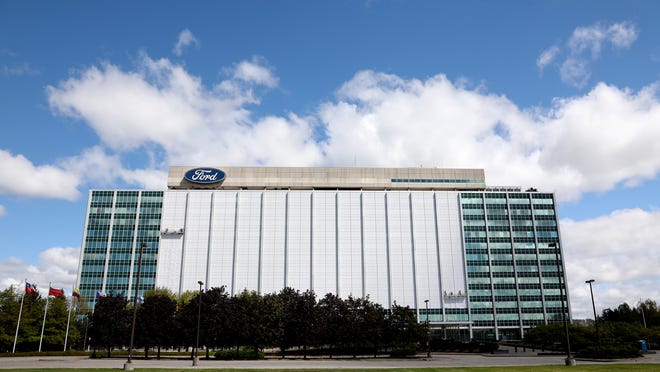(Update: Since this story published, Ford has released new information that solves the mystery. Sort of. See this link.)
Something is happening outside Ford World Headquarters in Dearborn.
The 12-story building built between 1953-56 is undergoing change.
Are the tinted, heat-absorbing glass windows being replaced?
“Nothing to share today. Details coming soon,” T.R. Reid told the Free Press late Friday.
Over the weekend, the Free Press learned a little more about what’s going on.
Men wearing high-visibility orange vests and fall-protection equipment stood on work platforms often used by window washers. The workers were not removing or replacing windows. The workers were in the process of installing a projection screen on the front of what’s known locally as the Glass House, on the side facing Michigan Avenue.
The projection screen, when fully installed, will be 64,000 square feet, according to a source with knowledge of the project but not authorized to discuss it publicly.

Early Monday, when asked again about the project or how the projection screen might be used, Reid declined to comment.
“Nothing to add,” he said. “But soon.”
One possibility, of course, is streaming video of the popular new upcoming Ford Bronco doing all the things that Ford has highlighted, such as rock crawling.
Response to the Bronco, built at the Michigan Assembly Plant in Wayne, has been overwhelming; 165,000 orders poured in immediately.
More:Ford to reveal new all-electric F-150 Lightning in livestream event May 19
Ford has launched four new 2021 model year signature products:
- Bronco built in Michigan
- F-150 built in Michigan and Missouri
- Mustang Mach-E built in Cuautitlán, Izcalli, Mexico
- Bronco Sport built in Hermosillo, Sonora, Mexico
Ford just ran a Mach-E spot during “Saturday Night Live” that streamed globally after host and Tesla CEO Elon Musk finished his opening monologue.

The Mach-E is designed to position Ford as a player in all-electric vehicles.
Ford CEO Jim Farley has called it transformational.
More:Ford CEO ‘humbled’ to team up with top environmentalist as part of global team
More:Ford ditches boring tutorials with new Mustang Mach-E videos
Modifying the world headquarters building, even just a little bit, makes a different kind of statement as the company competes in the all-electric space.

The Glass House has a storied history.
“In 1945, when Henry Ford II became president of Ford Motor Company, the company’s administration building that was constructed twenty-two years earlier next to the River Rouge plant seemed obsolete,” according to the Society of Architectural Historians website.
“The company decided to build a decentralized work center among lawns and trees in the center of Dearborn’s farmlands once owned by Henry Ford that would be remote from the grimy and congested city and close to the places where people preferred to live,” the website said.

Decades later, Ford decided to tint its 3,083 windows to reduce glare and absorb heat, according to The Filmshield Group website, touting its “energy-saving window film” project among company success stories.
“Ford says the company is now enjoying the benefits of an energy consumption reduction, which could save them an estimated $57,000 a year in energy costs,” said the website, which was undated but suggests mid-1990s.
“Prior to the installation, Ford could cool the building no lower than 80 degrees on hot summer days. In the building’s Trading Room, for instance, Ford employees had not been able to open their drapes for more than seven years, because the sunlight made it difficult to see their computer screens. Now those same employees enjoy being able to look outside during working hours.”
More:Iconic Detroit midcentury modern design themes inspire Mustang Mach-E
The concrete, steel and glass building — designed by the global firm Skidmore, Owings, and Merrill — is considered International Style as first coined by Museum of Modern Art curators in New York in the 1930s.
The International Style, also called Modern European Architecture Style, refers to architecture “that emerged in Holland, France, and Germany after World War I and spread throughout the world, becoming the dominant architectural style until the 1970s. The style is characterized by an emphasis on volume over mass, the use of lightweight, mass-produced, industrial materials, rejection of all ornament and color, repetitive modular forms, and the use of flat surfaces, typically alternating with areas of glass,” according to the Society of Architectural Historians site.
This past weekend in Dearborn,the source with knowledge of the projection screen project told the Free Press it would not interfere with the indoor work experience.
More:Ford puts properties on the selling block, 35 sites under review in Dearborn area
More:Ford unearths $100K in leather during demolition at Dearborn facility
In early 2016, Ford announced plans to redesign the campus starting in 2021. And that process has been sped up by the pandemic and a pivot to more remote work.
Contact Phoebe Wall Howard at 313-222-6512 orphoward@freepress.com.Follow her on Twitter@phoebesaid. Read more on Ford and sign up for our autos newsletter.
